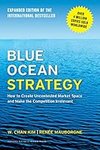
Saved by Ohh my and
Blue Ocean Strategy

Saved by Ohh my and
First tier: “Soon-to-be” noncustomers who are on the edge of your market, waiting to jump ship. Second tier: “Refusing” noncustomers who consciously choose against your market. Third tier: “Unexplored” noncustomers who are in markets distant from yours.
The second tier of noncustomers is people who refuse to use your industry’s offerings. These are buyers who have seen your industry’s offerings as an option to fulfill their needs but have voted against them.
A company should never outsource its eyes. There is simply no substitute for seeing for yourself. Great artists don’t paint from other people’s descriptions or even from photographs; they like to see the subject for themselves. The same is true for great strategists.
This brings us to the third principle of blue ocean strategy: reach beyond existing demand. This is a key component of achieving value innovation. By aggregating the greatest demand for a new offering, this approach attenuates the scale risk associated with creating a new market.
The four steps of visualizing strategy
What trends have a high probability of impacting your industry, are irreversible, and are evolving in a clear trajectory? How will these trends impact your industry? Given this, how can you open up unprecedented customer utility?
Rather, we’re talking about finding insight in trends that are observable today.
Rarely do sellers think consciously about how their customers make trade-offs across alternative industries. A shift in price, a change in model, even a new ad campaign can elicit a tremendous response from rivals within an industry, but the same actions in an alternative industry usually go unnoticed.
Which of the factors that the industry takes for granted should be eliminated? Which factors should be reduced well below the industry’s standard? Which factors should be raised well above the industry’s standard? Which factors should be created that the industry has never offered?